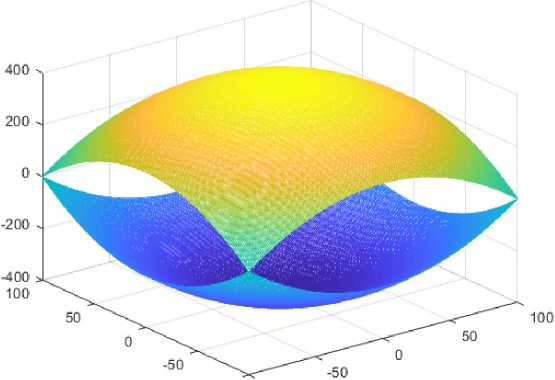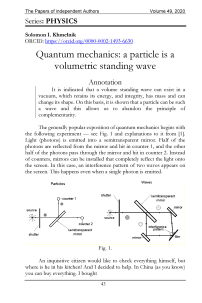Quantum mechanics: a particle is a volumetric standing wave
Автор: Solomon I. Khmelnik
Журнал: Доклады независимых авторов @dna-izdatelstwo
Рубрика: Physics
Статья в выпуске: 49, 2020 года.
Бесплатный доступ
It is indicated that a volume standing wave can exist in a vacuum, which retains its energy, and integrity, has mass and can change its shape. On this basis, it is shown that a particle can be such a wave and this allows us to abandon the principle of complementarity.
Короткий адрес: https://sciup.org/148311525
IDR: 148311525
Текст научной статьи Quantum mechanics: a particle is a volumetric standing wave
Quantum mechanics: a particle is a volumetric standing wave
Annotation
It is indicated that a volume standing wave can exist in a vacuum, which retains its energy, and integrity, has mass and can change its shape. On this basis, it is shown that a particle can be such a wave and this allows us to abandon the principle of complementarity.
The generally popular exposition of quantum mechanics begins with the following experiment — see Fig. 1 and explanations to it from [1]. Light (photons) is emitted into a semitransparent mirror. Half of the photons are reflected from the mirror and hit in counter 1, and the other half of the photons pass through the mirror and hit in counter 2. Instead of counters, mirrors can be installed that completely reflect the light onto the screen. In this case, an interference pattern of two waves appears on the screen. This happens even when a single photon is emitted.
Particles
Waves
Fig. 1.
An inquisitive citizen would like to check everything himself, but where is he in his kitchen! And I decided to help. In China (as you know) you can buy everything. I bought
-
1. A bottle with drops of a viscous very elastic liquid with a very strong surface film (even with a hammer!).
-
2. A pistol that shoots these drops.
-
3. A plate that transmits these drops or reflects them (with equal probability). And he called it a translucent mirror.
-
4. A plate that always reflects drops. And called it a mirror (ordinary).
-
5. A droplet trap, which has the property that a light bulb is lit on it when a drop enters it. And he called it a counter.
-
6. A plate covered with a sensitive emulsion, which has the property that a drop falling on it creates a tuberous circle on it. And called it plate a screen, and the bumpy circle - interference.
I repeated the above experiment and saw that everything happens in accordance with quantum mechanics! Thus, one can make sure that the complementarity principle is satisfied for the drops and the drop is a waveparticle. The latter is not surprising: it is known that even the Earth is a wave.
But then a doubt arose. Or maybe a drop DOESN'T bifurcate in a translucent mirror!? She, flying in one of two ways, would still flatten into a tuberous circle. And this doubt was reinforced by the impossibility of imagining the drop as a wave packet that flies at the speed of light when the drop lies still.

■100 -100
Fig. 2.
And then I remembered my recent article [2], where I showed the following based on the solution of Maxwell's equations. In a certain closed volume of vacuum, a standing electromagnetic wave can exist. This volume can, for example, have the shape shown in Fig. 2. The volume boundaries do not radiate and there are no internal heat losses. Therefore, such a wave can exist forever. In addition, the wave can change shape while maintaining its integrity and has mass.
If the bottle contained not drops, but such standing waves, then this experiment could be repeated and explained without invoking the principle of complementarity, and these standing waves (which that a drop falling on it is flattened into a tuberous circle) could be safely called particles-waves. And the principle of complementarity is not a pity at all. They say, "that the principle of complementarity demonstrates the philosophy of weakness, and the temporary role of this principle is obviously similar to the role of phlogiston and other obsolete concepts" [1]. [
But maybe we won't wait until a bottle with standing waves can be will be done in China, but will assume that the particles are volumetric standing waves ?


